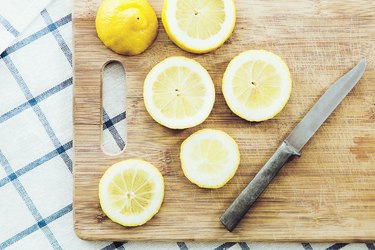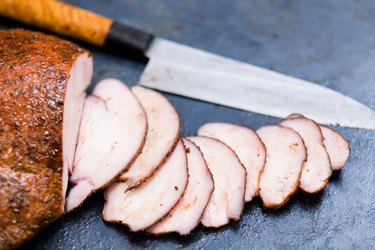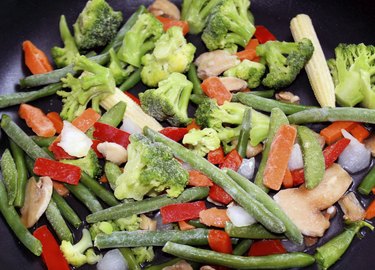If youre tired of eating the same old Thanksgiving turkey stuffing every year, change things up by stuffing your bird with fruit, such as oranges, lemons, and limes. Citrus fruit is the best fruit to stuff a turkey with for a moist, delicately flavored result.
Youll save calories and fat by not using traditional stuffing, which is typically loaded with butter that soaks into the meat. On the other hand, fresh citrus fruit creates a porous area inside the cavity and provides moisture that steams and seasons the meat.
Finally, youll want to add the right aromatics when youre using fruit to stuff turkey, as herbs and spices will leave you with fresh, flavorful meat.
For a fresh, vibrant flavor, stuff turkey with citrus fruit like oranges, lemons, and limes. The juices from the fruit impart flavor and add moisture to the bird.
Putting an orange in a turkey before roasting is a time-honored cooking tradition that many families follow every Thanksgiving. But where did this peculiar practice originate, and what purpose does the orange serve inside the bird? In this article, we’ll explore the history behind stuffing turkeys with citrus and examine the science and benefits of using oranges to enhance flavor and moisture.
A Brief History of Oranges and Turkeys
The tradition of putting oranges in turkeys dates back over a century. In the early 1900s before advanced refrigeration cooks employed this technique as a natural way to preserve and add subtle flavor to meats. The acidity from citrus fruit helps tenderize tough proteins. Their high moisture content also prevents lean meats from drying out.
Oranges became especially popular for stuffing in turkeys, favored for their sweet, tangy juice over other citrus. By the early 20th century, it became tradition to place orange halves inside the cavity alongside the traditional bread-based stuffing before roasting. The orange inserted in the turkey became an iconic part of the Thanksgiving meal.
Why Do Cooks Still Use Oranges Today?
In modern times most cooks don’t have to worry about meat preservation. So why do they continue using oranges? The reasons are simple – for added moisture and flavor!
As the orange roast alongside the turkey, its juices permeate the meat, imparting a subtle citrusy sweetness. The high moisture content also ensures the lean turkey breast stays succulent. The orange provides the right balance of flavor and steam to prevent dry, tough meat.
Orange juice and oils also help counteract the naturally gamy flavor in dark turkey meat. When stuffed inside, oranges provide a refreshing fragrance that makes the turkey more universally appealing.
Alternative Ways to Use Oranges
If you don’t want to stuff an entire orange inside, there are alternatives:
-
Place orange slices underneath the turkey to add steam and moisture from below.
-
Make an orange-infused glaze from juice, honey, and spices to lacquer the skin.
-
Rub seasoned orange zest and juice directly onto the skin and underside.
-
Cook turkey over a bed of orange aromatics like onions, garlic, and herbs.
-
Serve turkey with a fresh orange cranberry sauce or citrus gravy.
Benefits of Cooking Turkey with Oranges
Using oranges to flavor and steam turkey provides numerous benefits:
-
Infuses moisture into lean breast meat, keeping it tender and juicy
-
Provides a bright, citrusy aroma that enhances turkey’s savory flavor
-
Adds subtle sweetness and tanginess that cuts through the richness
-
Naturally tenderizes turkey by breaking down tough proteins and collagen
-
Fresh orange juice contains immune-boosting vitamin C
-
Masks strong “gaminess” sometimes found in dark turkey meat
-
Makes a beautiful table presentation when roasted orange peeks through cavity
How to Prepare an Orange-Stuffed Turkey
To get the most out of oranges, here are some tips when stuffing them inside turkey:
-
Choose fresh oranges with firm skins. Wash thoroughly before slicing.
-
Cut 1-2 large oranges into rounds or thick wedges. Stuff loosely in cavity.
-
Combine orange with onions, garlic, herbs for extra aroma and moisture.
-
Truss up turkey legs and tie with cooking twine to seal in steam.
-
Roast turkey in 400°F oven until internal temperature reaches 165°F.
-
Baste turkey frequently with pan juices for maximum orange infusion.
-
Rest cooked turkey at least 15 minutes before carving, keeping orange inside.
Cooking Methods for Orange-Infused Turkey
You can make turkey infused with fresh orange flavor through various cooking techniques:
-
Roasting – The traditional way. Baste frequently with orange juice.
-
Grilling – Adds smoky flavor. Use indirect heat so it cooks evenly.
-
Smoking – Infuses rich, wood-smoked taste. Ideal for smaller cuts like breasts.
-
Braising – Slow cook turkey legs or wings in an orange sauce.
-
Sous Vide – Locks in moisture and concentrated flavor. Works great for turkey breast.
No matter which technique you use, oranges impart delicious citrus aroma and sweet, tangy juice that takes turkey from bland to spectacular!
Satisfy Your Citrus Craving This Thanksgiving
This Thanksgiving, embrace the timeless tradition of stuffing an orange inside your holiday turkey. Not only does it look beautiful when roasted, it also delivers incredibly moist, flavorful meat infused with sunshine-y citrus essence. For a perfect balance of savory and sweet flavors, don’t forget the orange! It may just become your new secret ingredient for spectacular turkeys.

How to Stuff Turkey With Fruit
- Citrus fruit, such as oranges, lemons, and limes
- Turkey
- Paper towels
- Sharp knife
- Cutting board
- Fresh herbs
- Cooking string
To stuff turkey with citrus fruit, youll first need to cut the fruit on a clean cutting board with a sharp chefs knife. Then, follow these instructions:
- Rinse the inside and outside of the turkey with cold water. Pat the surfaces dry with a paper towel.
- Wash the outside of an orange, lemon, and lime with water. Cut the citrus into quarter-sized wedges with a sharp knife and cutting board.
- Rinse three or four sprigs of fresh herbs with water. Herbs that complement turkey are rosemary, thyme or marjoram.
- Stuff the orange, lemon, and lime wedges into the turkey cavity with your hands, and then stuff in the herbs. Any unused citrus wedges can be used as a garnish on the turkey platter.
- Tie the legs together with some cooking string to keep moisture and heat inside the turkey for steaming the citrus.
- Cook the turkey in a 400-degree Fahrenheit oven until the internal temperature in the thigh and breast is 165 F or higher.
- Leave the citrus in the turkey as it cools for additional moisture. Discard the citrus when done carving.
Cut an onion and a garlic clove into wedges and insert them into the turkey cavity with the citrus wedges for additional flavor. Wash your hands before and after handling a raw turkey.



Cooking Turkey with Oranges Inside
FAQ
Why do people put oranges in turkeys?
Stuffing the turkey with orange gives the meat a bright, zesty flavor and moistens the bird. That’s always a challenge with such lean meat.Oct 8, 2024
What is the best fruit to put in a turkey?
Apples, Oranges & Lemons: this combination of fruit adds both flavor and extra moist inside the turkey, keeping it juicy!
Do you stuff a turkey with an orange?
Rinse turkey inside and out and pat dry. Sprinkle turkey inside and out with salt and pepper, then fold neck skin under body and secure with small skewer. Stuff large cavity with oranges, 1 onion, and bay leaves. Tie drumsticks together with kitchen string and secure wings to body with small skewers.
Are oranges good for turkeys?
Citrus Fruits: While there have been anecdotal reports that feeding turkeys citrus may cause excessive preening or feather plucking and interfere with calcium absorption, there are multiple studies that show citrus, processed in certain forms, may be used in their diets and may be beneficial to the health of turkeys in …
Why do you put an orange in a Turkey?
Some people believe that the orange adds a distinct citrus flavor to the turkey, while others believe it simply helps keep the meat juicy. Regardless of the reason, putting an orange in a turkey has become a beloved tradition for many families during the holiday season.
Can you put oranges in a Turkey?
Beyond stuffing it inside the raw turkey, there are also creative ways to incorporate oranges into your Thanksgiving bird: Orange Glaze – Brush turkey with a sticky glaze of orange juice, honey, and spices for crispy, lacquered skin. Orange Butter – Rub seasoned orange butter under and on top of skin for incredible flavor and aroma.
Why do roasted turkeys eat oranges?
The moisture released from the orange provides the right amount of steam to prevent the meat from becoming tough and chewy. So in short, oranges impart just the right balance of sweet, citrusy flavor notes and moisture to take your roasted turkey to the next level.
How do you eat orange roasted turkey?
Slice into thick rounds or large wedges. Stuff loosely into cavity along with aromatics like onions, garlic, fresh herbs. Baste turkey with pan juices often for maximum flavor infusion. Let orange remain in turkey cavity as it rests before carving for added moisture. Squeeze roasted orange over finished turkey or use in gravy for bonus flavor.
What does orange taste like in a turkey breast?
The orange infuses the turkey with a subtle sweetness and citrusy aroma that perfectly complements the savory meat. Meanwhile the high moisture content of the fresh orange helps ensure the lean turkey breast stays deliciously juicy and does not dry out.
Can you put orange stuffing inside a Turkey?
If you’re not a fan of the traditional stuffing inside the turkey, there are plenty of orange alternatives that can add a fresh and unique flavor to your holiday meal. One option is to chop up oranges and use them as a bed for the turkey to rest on while it cooks.
